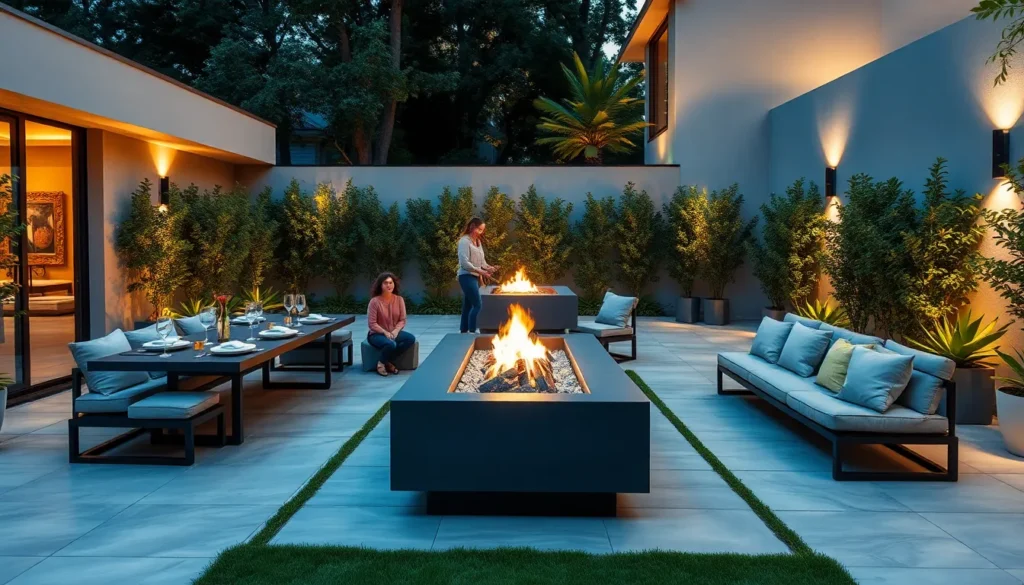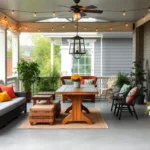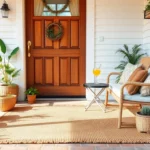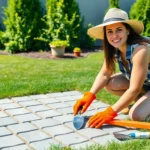Rectangular patios offer endless possibilities for creating stunning outdoor spaces that perfectly balance form and function. Whether you’re working with a small backyard or a sprawling industry we’ll show you how to transform your rectangular patio into an inviting retreat that reflects your personal style.
We’ve discovered that the key to maximizing rectangular patio layouts lies in understanding how to divide and define different zones within your space. From cozy dining areas to relaxing lounge spots these versatile layouts can accommodate everything your family needs for outdoor entertaining and relaxation.
Ready to unlock your patio’s full potential? We’ll explore creative design strategies that make rectangular spaces feel both spacious and intimate while maximizing every square foot for maximum enjoyment.
Modern Minimalist Rectangular Patio Layouts
Modern minimalist designs transform rectangular patios into sleek outdoor sanctuaries. We’ll explore how strategic furniture placement and cohesive color palettes create sophisticated entertaining spaces.
Clean Lines and Geometric Furniture Arrangements
Straight edges define the foundation of minimalist rectangular patio layouts. We position furniture in parallel lines to echo the patio’s natural geometry, creating visual harmony throughout the space. Rectangular dining tables, linear benches, and square planters reinforce this geometric theme.
Symmetrical placement anchors the design with purposeful balance. We arrange matching lounge chairs on opposite sides of a central coffee table, establishing a focal point that draws guests into the conversation area. This approach maximizes both visual impact and functional flow.
Floating furniture creates breathing room within the rectangular boundaries. We place seating groups away from walls and edges, allowing pathways around each piece. This technique makes even compact patios feel more spacious and inviting.
Built-in elements streamline the overall aesthetic while maximizing square footage. We integrate rectangular fire pits, linear water features, or geometric planters directly into the patio design. These permanent fixtures eliminate clutter while maintaining the clean minimalist appeal.
Monochromatic Color Schemes for Streamlined Appeal
Neutral foundations establish sophisticated rectangular patio color schemes. We select whites, grays, and blacks as primary colors, creating a cohesive backdrop that complements any architectural style. These timeless shades reflect light and make rectangular spaces appear larger.
Textural variety adds visual interest without disrupting the monochromatic flow. We incorporate different materials like smooth concrete, weathered wood, and brushed metal in similar tones. This layering technique prevents the space from feeling flat or boring.
Strategic accent colors provide subtle pops of personality within the restrained palette. We introduce single bold colors through cushions, planters, or artwork, typically limiting ourselves to one accent hue per rectangular patio. This restraint maintains the minimalist aesthetic while adding warmth.
Lighting integration enhances the monochromatic scheme during evening hours. We install linear LED strips under benches, geometric pendant lights over dining areas, and recessed fixtures in walkways. This consistent lighting reinforces the clean lines while extending the patio’s usability into the night.
Traditional Rectangular Patio Design Concepts
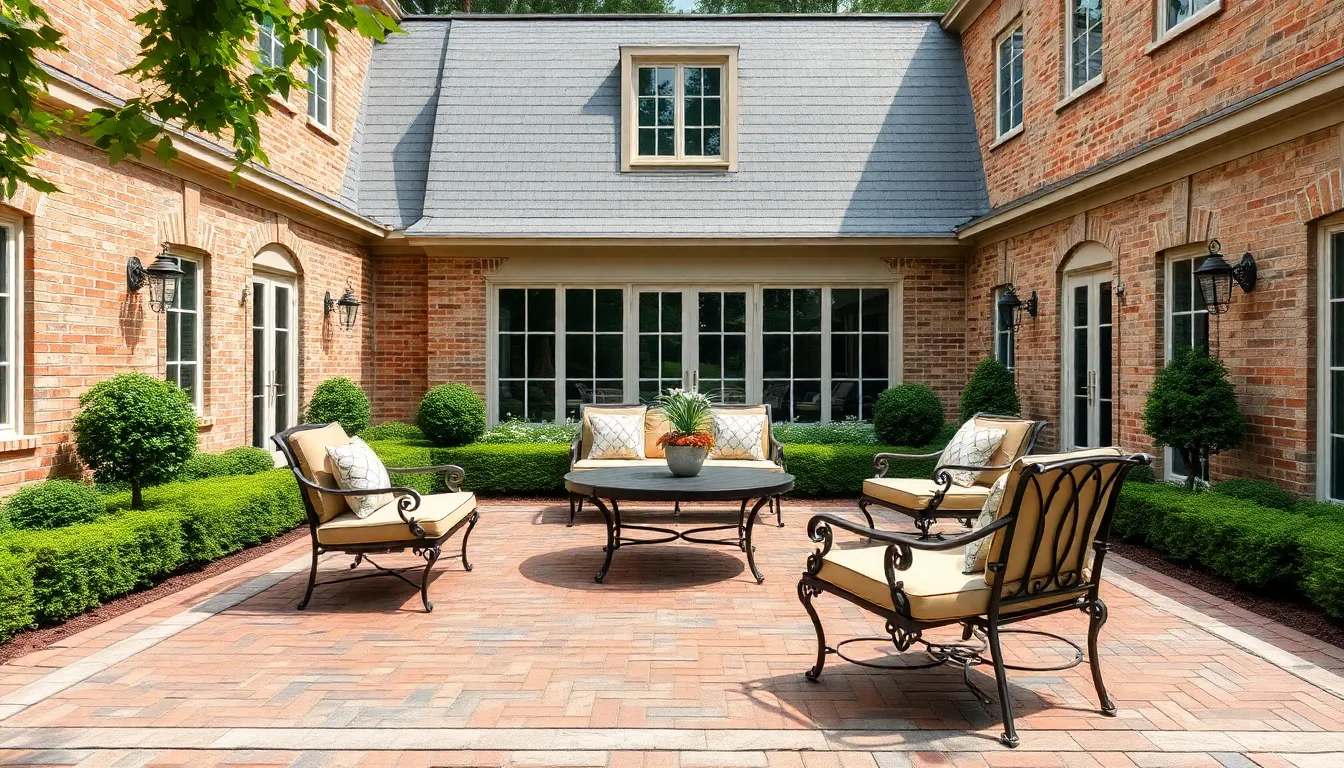
Traditional rectangular patios offer timeless elegance through structured layouts that emphasize symmetry and classic materials. We’ll explore how these enduring design principles create sophisticated outdoor spaces that complement both home architecture and garden landscapes.
Classic Brick and Stone Patterns
Herringbone patterns transform ordinary rectangular patios into stunning visual displays while providing exceptional durability. We recommend this intricate brick arrangement for homeowners seeking texture and visual interest in their outdoor spaces. The interlocking design creates a strong surface that withstands heavy foot traffic and weather conditions.
Basketweave configurations offer another sophisticated option that adds dimensional texture to traditional patio designs. These patterns work particularly well in formal settings where geometric precision enhances the overall aesthetic appeal.
Running bond layouts deliver clean, linear appearances that complement rectangular patio shapes perfectly. We find this brick pattern especially effective for creating seamless transitions between indoor and outdoor living areas. The straightforward arrangement maintains visual continuity while providing reliable structural integrity.
Flagstone installations bring natural beauty to rectangular spaces through both structured grids and balanced irregular arrangements. We often specify natural stone for clients wanting rustic elegance that integrates seamlessly with garden surroundings. Earthy tones in these materials enhance traditional appeal while creating harmonious connections with industry elements.
Formal Garden Integration Techniques
Symmetrical alignments establish rectangular patios as focal points within formal garden settings. We position these spaces to align with garden paths, fountains, or statuary to emphasize order and balance throughout the industry design. This approach creates visual continuity that strengthens the connection between hardscape and softscape elements.
Defined borders frame rectangular patios using low hedges, boxwood plantings, or stone edging to reinforce formal styling. We select these boundary treatments to create clean transitions while maintaining the structured appearance that defines traditional garden design. These elements provide clear spatial definition without overwhelming the patio’s proportions.
Functional zoning separates rectangular patio areas into distinct spaces for dining, lounging, and cooking while preserving visual flow. We accomplish this through strategic furniture placement and pathway design that maintains connectivity with garden beds and lawn areas. Wrought iron and teak furniture selections enhance this formal integration by providing classic materials that complement traditional styling.
Strategic pathways connect rectangular patios to surrounding garden areas while maintaining structural integrity throughout the industry. We design these circulation routes to blend built environments with natural settings, ensuring smooth transitions that respect both patio functionality and garden aesthetics.
Small Rectangular Patio Layout Solutions
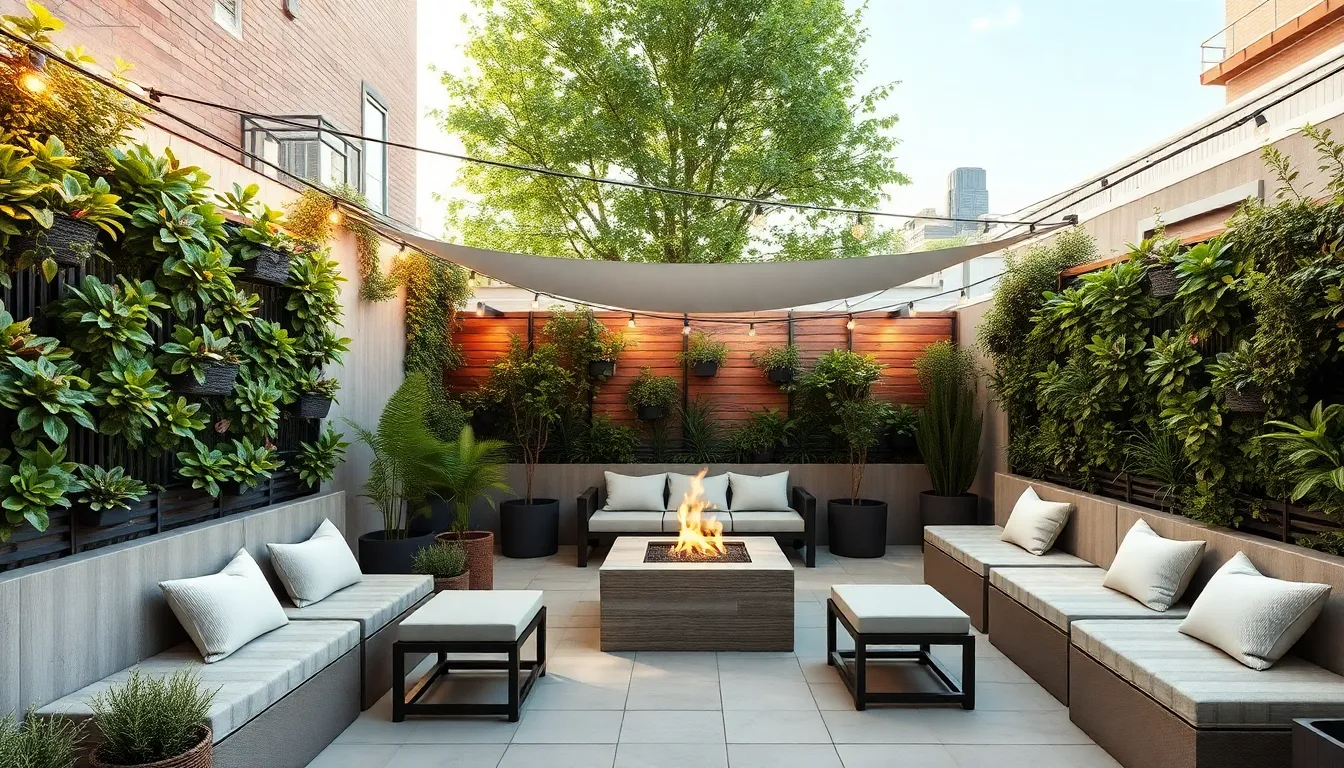
Working with smaller rectangular patios requires strategic design choices that maximize every square foot while maintaining comfort and style.
Space-Maximizing Furniture Placement
Corner optimization transforms unused patio spaces into functional areas. We recommend placing compact seating arrangements or decorative planters in these often overlooked corners to create visual interest without crowding the main walkways.
Built-in seating answers eliminate the need for additional floor space. Benches and seat walls integrate seamlessly into your patio design while providing ample seating for guests. These permanent fixtures don’t require extra paving space and can double as storage or display areas.
Stackable furniture pieces offer incredible versatility for small patios. Chairs, stools, and side tables that nest together can be easily stored when you need maximum open space for entertaining or activities.
Multi-level arrangements create distinct zones within your compact patio. Elevating certain areas for dining while keeping lounging spaces at ground level adds visual depth and helps define separate functional areas without physical barriers.
Fire pit installations serve as natural gathering points in small rectangular spaces. These recessed features can be positioned centrally to create intimate seating arrangements while maximizing the available floor space around the perimeter.
Vertical Design Elements for Compact Areas
Wall-mounted planters bring greenery to eye level without sacrificing floor space. These vertical garden answers create lush backdrops while keeping your patio floor clear for furniture and foot traffic.
Hanging light fixtures illuminate your space from above. String lights, pendant lamps, and wall-mounted sconces provide essential lighting while maintaining an open feel throughout your rectangular patio.
Canopy installations offer overhead coverage with minimal ground footprint. Retractable awnings and fixed canopies provide shade and weather protection while preserving valuable patio real estate below.
Vertical storage answers keep essentials organized and accessible. Wall-mounted cabinets, hooks, and shelving systems store outdoor cushions, dining accessories, and gardening tools without cluttering the main patio area.
Climbing plant structures add natural beauty to vertical surfaces. Trellises and wire supports allow vines and climbing plants to create living walls that enhance privacy and visual appeal.
Large Rectangular Patio Layout Strategies
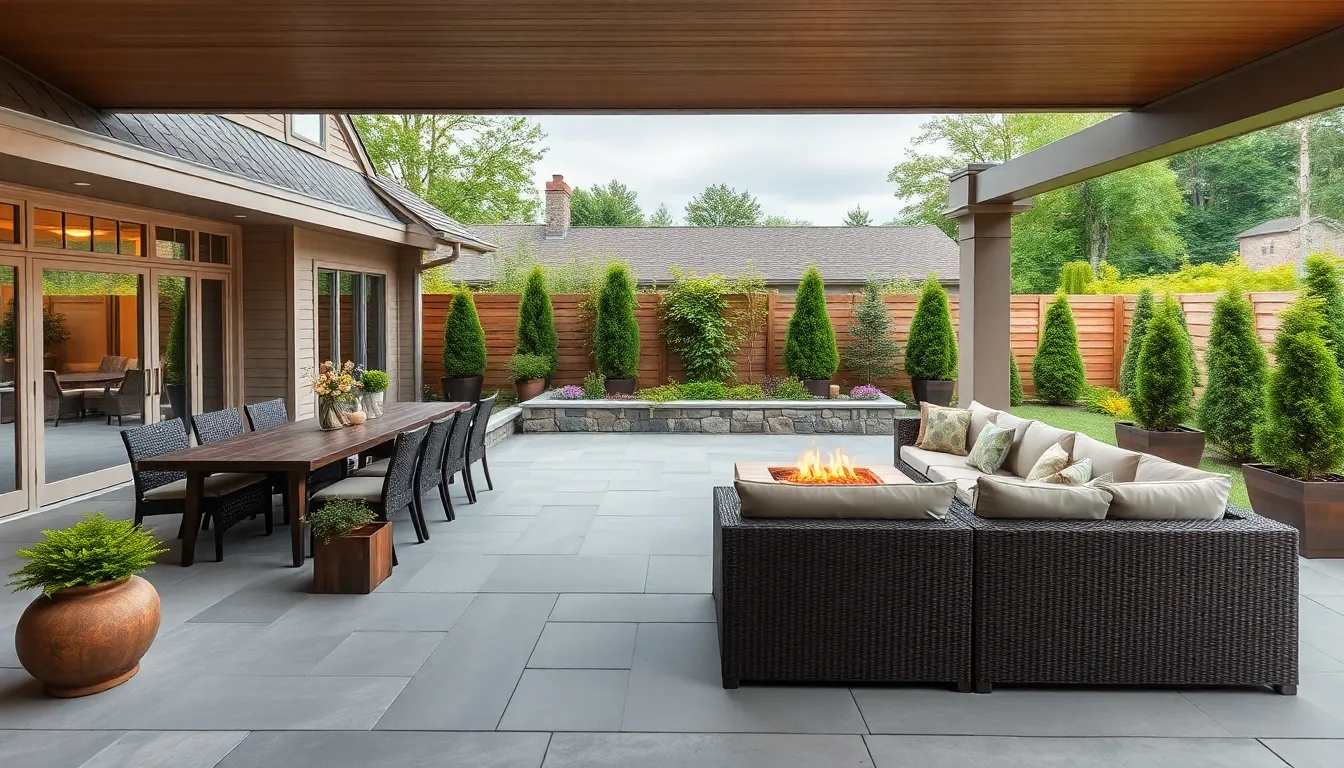
Large rectangular patios present incredible opportunities to create sophisticated outdoor living environments that rival interior spaces. We’ll explore proven strategies that transform expansive rectangular areas into functional, beautiful outdoor sanctuaries.
Zone Creation for Multiple Activity Areas
Dedicated dining zones establish formal eating areas by positioning rectangular dining tables parallel to the patio’s longest edge. We recommend placing these zones away from high-traffic pathways to maintain intimate conversation spaces during meals.
Lounging areas work best when centered around focal features like fire pits or coffee tables. Position modular seating arrangements in L-shaped or U-shaped configurations to encourage social interaction while maintaining clear sight lines across the entire patio.
Cooking zones require strategic placement near utility connections while maintaining safe distances from seating areas. We suggest locating outdoor kitchens or grill stations along one shorter edge of the rectangle to optimize workflow and ventilation.
Clear pathways between zones prevent overcrowding and enhance accessibility throughout the space. Create walking corridors that are at least 3 feet wide to ensure comfortable movement between different activity areas.
Visual separators like area rugs, subtle paving material changes, or low planters help define each zone without creating barriers. These elements maintain the open feel while providing clear functional boundaries for different activities.
Grand Scale Furniture and Feature Integration
Oversized sectional sofas complement large rectangular layouts by filling space proportionally without overwhelming the design. We recommend positioning these statement pieces to anchor major seating zones while leaving adequate circulation space around all sides.
Expansive dining tables that seat 8-12 people work beautifully in large rectangular patios. Choose tables with clean lines that echo the patio’s geometric shape for visual harmony.
Built-in seating walls maximize seating efficiency while saving valuable floor space. Position these architectural elements along the patio’s perimeter, leaving corners open to preserve the most desirable seating spots.
Large-scale fire features serve as natural gathering points and architectural focal elements. We suggest installing these centrally located features to create warmth and ambiance that draws people together from all zones.
Architectural steps that run the full length of the patio add visual interest while providing practical access to different levels. These features work especially well when connecting the main patio to secondary outdoor areas or garden spaces.
Secondary paved areas using the “Outside Box” approach create intimate nooks within the larger space. These smaller adjoining areas can house specialty features like hot tubs or quiet reading corners while maintaining connection to the main patio.
Rectangular Patio Layouts for Entertaining

Entertaining on a rectangular patio requires strategic layout planning to create spaces where guests can comfortably socialize, dine, and move freely throughout the area.
Optimal Seating Arrangements for Gatherings
Open concept seating transforms your rectangular patio into a natural conversation hub. Arrange modular or sectional seating around a central feature like a fire pit or coffee table to promote interaction among guests. This setup creates a cozy gathering spot while ensuring the furniture layout allows for easy movement and mingling.
Zoned seating areas maximize functionality by creating distinct spaces for different activities. Divide your patio into separate zones such as a lounging area and dining area using visual separators like rugs or changes in flooring style. This approach helps guests choose spaces based on their preferred activity, whether they want to relax or engage in more active conversation.
Flexible furniture arrangements adapt to various gathering sizes and types. Use lightweight or movable furniture pieces that you can easily reconfigure depending on whether you’re hosting intimate gatherings or larger groups. This versatility ensures your rectangular patio entertaining space remains comfortable regardless of the number of guests.
Bar and Dining Area Positioning
Dining area placement should prioritize convenience and accessibility for seamless entertaining. Position your dining set where it has easy access to the house or kitchen to simplify serving and cleanup. Rectangular patios work best when you place the dining area along one side, maintaining open circulation space for guest movement.
Bar setup integration creates a natural gathering point without causing congestion. Install your bar area either as a standalone feature or combined with your outdoor cooking space, positioning it near the dining zone while maintaining enough distance to prevent crowding. This strategic placement allows guests to gather at the bar while others dine or lounge freely throughout the space.
Clear pathway design ensures smooth traffic flow between all entertaining zones. Leave adequate room for pathways between your bar, dining, and seating areas so guests can move comfortably without creating bottlenecks. Use visual separators like rugs, planters, or low dividers to define zones while maintaining an organized and user friendly layout during social events.
Family-Friendly Rectangular Patio Configurations
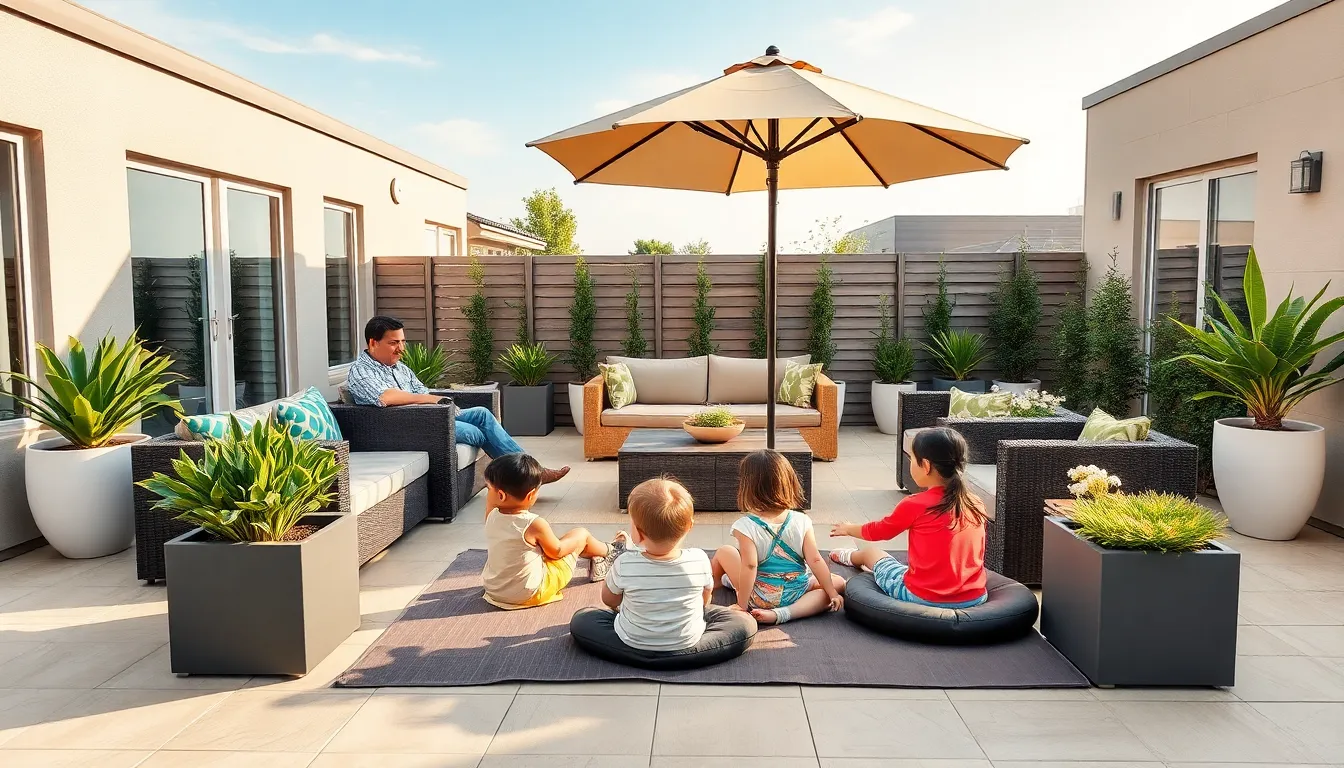
Rectangular patios offer excellent opportunities to create dedicated family spaces that balance adult entertainment with child friendly design elements.
Kid-Safe Design Elements and Play Zones
Safety surfaces form the foundation of every family oriented rectangular patio design. We recommend installing smooth, non-slip materials like textured concrete pavers or rubberized deck tiles that prevent falls while maintaining visual appeal. Rounded edge furniture eliminates sharp corners that pose injury risks, particularly for active children who love to run and play outdoors.
Designated play areas maximize both safety and functionality within rectangular layouts. We suggest allocating a corner section with cushioned outdoor mats or weather resistant rugs where kids can engage in safe ground activities. Natural barriers using decorative planters or low retaining walls create visual boundaries that keep children within sight while allowing supervised independence.
Strategic zoning separates active play spaces from quiet adult areas without compromising family interaction. Position play zones away from cooking areas and breakable decor, using portable storage benches to organize toys and games. Weather resistant toy storage answers maintain organization while protecting outdoor play equipment from seasonal elements.
Durable material choices ensure long term safety and easy maintenance for busy families. We prioritize materials that resist staining, scratching, and weather damage while remaining comfortable for barefoot children during summer play sessions.
Multi-Generational Seating Answers
Versatile seating arrangements accommodate different age groups and physical needs across extended families. We recommend incorporating benches for stable seating that supports elderly family members, individual lounge chairs for personal comfort, and cushioned sofas that welcome multiple generations during gatherings.
Symmetrical furniture placement promotes inclusivity and natural conversation flow between grandparents, parents, and children. Central coffee tables or fire pit areas create focal points where all ages can gather comfortably, while maintaining clear sight lines for supervision and interaction.
Modular furniture systems offer flexibility for various family activities and seasonal changes. Pieces can be rearranged for intimate conversations, large holiday gatherings, or children’s birthday parties without requiring permanent layout modifications. Lightweight yet sturdy options allow easy reconfiguration as family needs evolve.
Comfort enhancements support extended outdoor time for all family members. Shade structures or large umbrellas protect sensitive skin and provide relief during hot summer days, while weather resistant cushions ensure comfort across different seasons. Strategic placement of side tables accommodates drinks, books, and personal items for each age group.
Accessible design features ensure every family member can navigate and enjoy the patio space safely. Wide pathways between seating areas accommodate mobility aids, while varying seat heights cater to different physical abilities and preferences throughout multi generational gatherings.
Rectangular Patio Layouts with Pool Integration
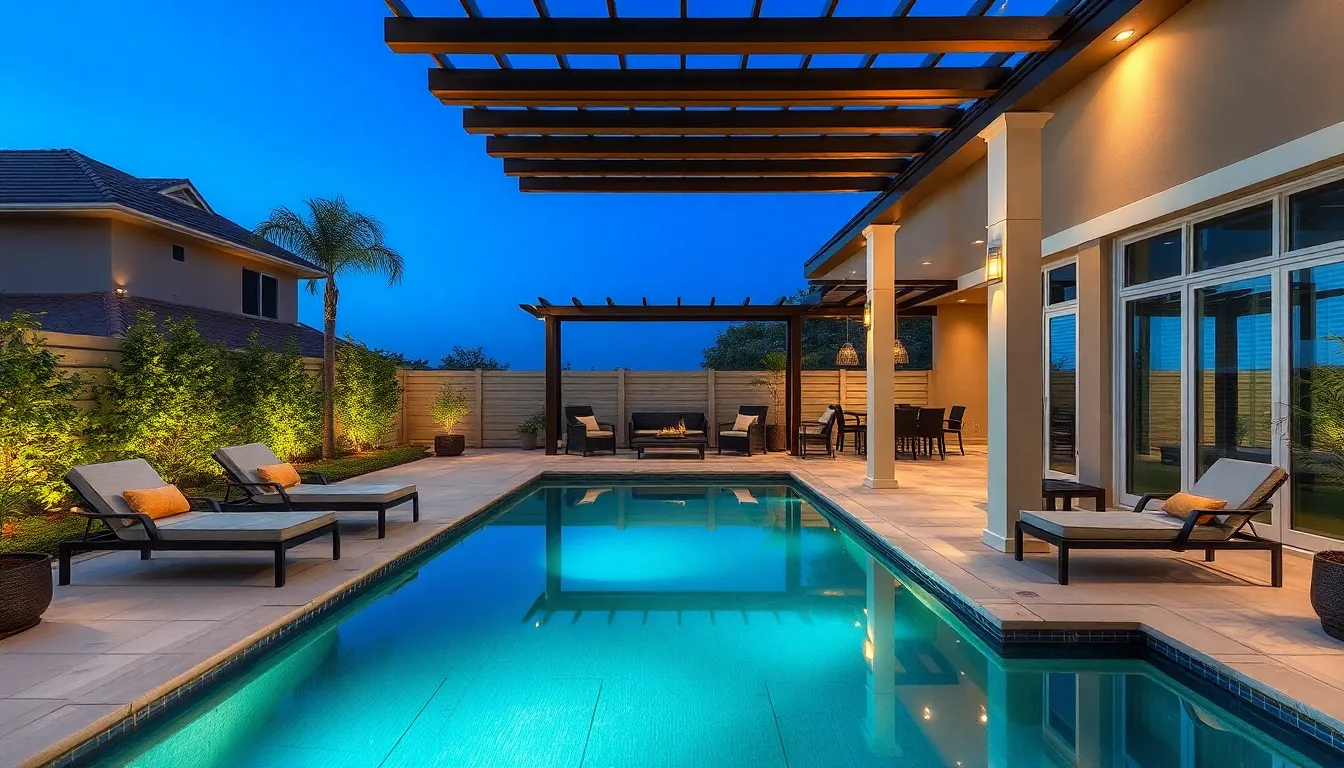
Integrating a pool into our rectangular patio design requires careful spatial planning to ensure the water feature complements rather than dominates the outdoor living space. Strategic placement creates seamless transitions between swimming and entertaining areas while maintaining the structured elegance that makes rectangular layouts so appealing.
Poolside Lounging Area Design
Adjacent positioning of lounging areas to the pool edge maximizes our functional use of space while creating natural flow between water activities and relaxation zones. We recommend placing chaise lounges and comfortable outdoor furniture parallel to the pool’s longest side, maintaining consistent spacing that allows easy movement between seating options.
Durable materials become essential for poolside furniture selections, with weather-resistant options like teak, aluminum, or all-weather wicker providing longevity against constant moisture exposure. Small side tables positioned between loungers offer convenient surfaces for drinks and personal items without cluttering the walkways.
Shade structures such as pergolas or gazebos define our lounging spaces while providing necessary sun protection during extended poolside relaxation. PowerGazebo installations can offer energy-efficient benefits through solar energy utilization, combining functionality with environmental consciousness.
Consistent flooring materials between the patio and pool deck create visual cohesion that enhances the overall design aesthetic. Natural stone pathways leading from lounging areas to covered dining spots establish clear traffic patterns while maintaining the rectangular layout’s structured appeal.
Multi-level integration allows us to create distinct poolside zones without sacrificing the rectangular patio’s clean lines. Elevated lounging platforms or sunken seating areas add architectural interest while providing varied perspectives of both the pool and surrounding industry.
Safety and Accessibility Considerations
Slip-resistant surfaces become paramount around pool edges and throughout the entire patio layout, preventing accidents during wet conditions. We prioritize materials with textured finishes that maintain grip even when splashed with pool water.
Strategic lighting design illuminates pathways, steps, and pool edges for safe nighttime navigation, reducing accident risks significantly. Well-placed fixtures highlight potential hazards while creating ambient atmosphere for evening entertaining.
Smooth transitions between different patio levels and from house to pool area ensure accessibility for all users, eliminating trip hazards that could cause injuries. Where elevation changes are necessary, we design wide steps with proper handrails for additional support.
Open corner design maximizes usability by avoiding obstructive columns or structures in key seating areas, following expert patio design principles that prioritize both safety and functionality. Seat walls save space while reducing trip hazards compared to loose furniture arrangements.
Clear pathway planning maintains unobstructed routes between pool access points and lounging areas, ensuring emergency situations can be handled quickly and efficiently. We design these pathways wide enough for comfortable passage even when furniture is occupied.
Visual barriers using low planters or decorative elements provide subtle separation between pool and patio zones without creating accessibility obstacles. These features enhance safety by clearly defining different areas while maintaining the open feel that makes rectangular layouts so appealing.
Garden-Integrated Rectangular Patio Ideas
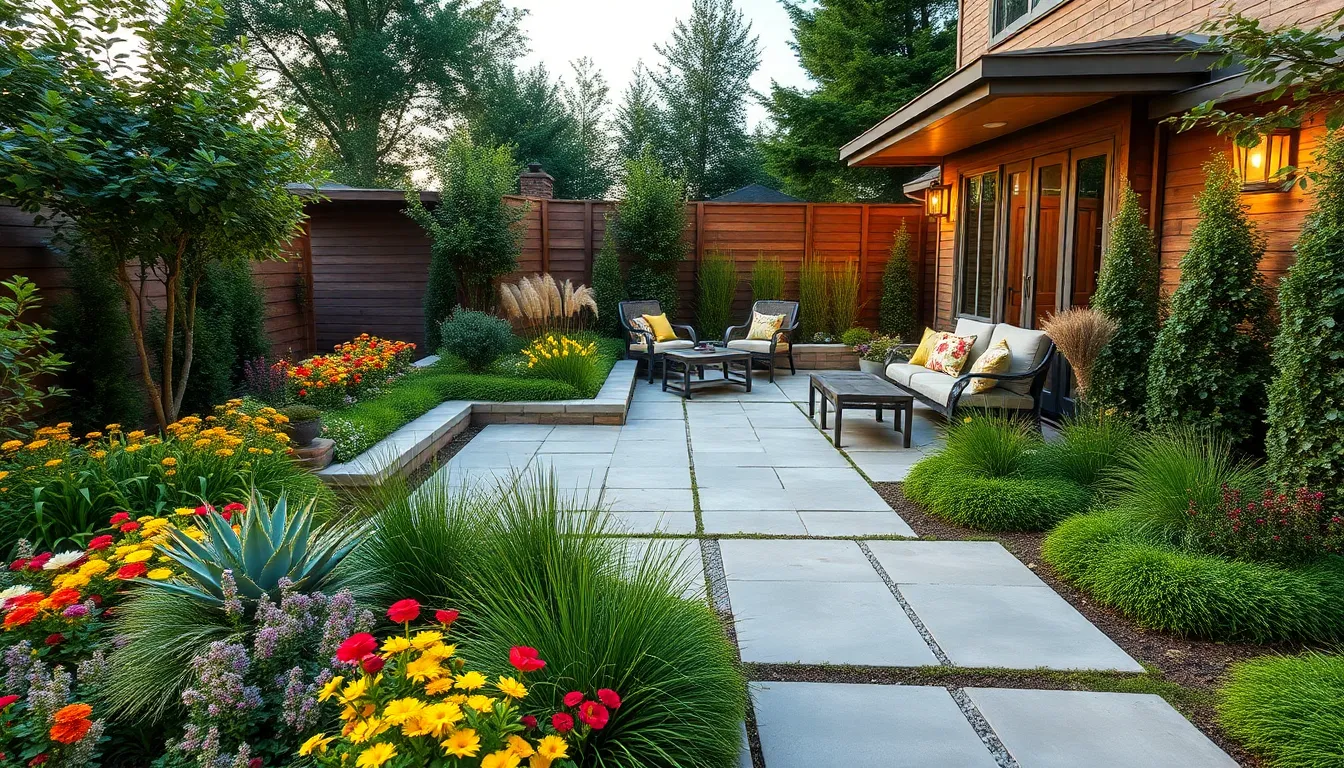
Rectangular patios transform into stunning outdoor retreats when we seamlessly blend them with surrounding gardens. Strategic garden integration creates natural flow between hardscaped entertaining areas and lush planted landscapes.
Planting Bed Incorporation Strategies
Perimeter planting beds soften the rigid edges of rectangular patios while creating natural transitions into garden spaces. We recommend positioning raised beds along one side of your patio to serve dual purposes as natural boundaries and additional seating options when built at appropriate heights.
Strategic placement of planting beds can effectively divide your rectangular patio into distinct functional zones. Dining areas benefit from separation through low planted dividers filled with perennials like lavender or ornamental grasses, while lounging spaces gain privacy through taller shrub plantings positioned thoughtfully around seating arrangements.
Built-in planters integrate seamlessly into rectangular patio designs when constructed using matching materials. Stone or brick planters echo hardscape elements while housing seasonal flowers that add color contrast throughout the year. Mixed plantings combining evergreen shrubs with flowering perennials ensure year-round visual interest and structure.
Corner planting beds maximize unused patio corners by transforming them into focal points. We suggest incorporating a mix of heights and textures through combinations of small trees, medium shrubs, and ground cover plants that create layered visual depth without overwhelming the space.
Natural Border and Edging Techniques
Organic edging materials like natural stone, weathered brick, or reclaimed timber create smooth transitions between rectangular patios and garden beds. These materials harmonize with existing industry elements while defining clean boundaries that enhance rather than compete with your patio’s geometric form.
Low hedge borders using boxwood, dwarf barberry, or compact holly varieties provide structured definition along patio edges. Ornamental grasses such as fountain grass or blue fescue offer softer alternatives that sway gently in breezes while maintaining clear spatial boundaries between paved and planted areas.
Mulched pathways connecting your rectangular patio to surrounding garden zones create natural walking surfaces that complement both hardscape and industry elements. Decomposed granite, pine bark, or river rock paths guide foot traffic while establishing visual continuity throughout your outdoor space.
Ground cover plantings along patio perimeters blur harsh lines between rectangular hardscaping and organic garden forms. Creeping thyme, sedum varieties, or pachysandra spread naturally beyond defined borders, creating the impression that your patio emerges organically from the surrounding industry rather than imposing upon it.
Rectangular Patio Lighting Layout Plans

Creating the perfect lighting scheme transforms your rectangular patio into a welcoming space that extends your home’s functionality well into the evening hours. Strategic illumination enhances both the aesthetic appeal and practical usability of your outdoor living area.
Ambient Lighting Placement Options
Perimeter lighting defines your rectangular patio boundaries while establishing a warm, inviting atmosphere throughout the entire space. We recommend installing string lights or lanterns along the outer edges to create consistent illumination that wraps around your patio’s geometric form. Solar-powered options offer energy efficiency and eliminate the need for complex electrical installations.
Overhead installations provide excellent ambient coverage when positioned within gazebos or pergolas above your patio area. Pendant lights and outdoor chandeliers create focal points while delivering functional illumination for evening gatherings. These elevated fixtures distribute light evenly across your rectangular layout without cluttering floor space.
Multi-level positioning works particularly well with tiered patio designs that feature different elevation zones. Place ambient fixtures at varying heights to complement your patio’s architectural depth and separate activity areas naturally. This layered approach ensures each level receives appropriate illumination while maintaining visual harmony throughout your outdoor space.
Task and Accent Lighting Answers
Pathway illumination ensures safe navigation around your rectangular patio’s perimeter and connecting walkways. Solar-powered or LED lights embedded directly into the ground highlight steps and transitions between different patio zones. These fixtures prevent accidents while guiding guests naturally through your outdoor living areas.
Spotlighting features draws attention to exact architectural elements like fire pits, water features, or decorative sculptures within your patio layout. Directional lights positioned strategically around these focal points enhance their visual appeal during evening hours. We suggest using adjustable fixtures that allow you to modify beam angles based on seasonal changes or special events.
Safety-focused installations illuminate critical areas where guests transition between different patio zones or navigate elevation changes. Focus these task lights on steps, seating edges, and cooking areas to prevent accidents while maintaining your patio’s aesthetic appeal. LED options provide bright, consistent illumination while consuming minimal energy throughout extended evening use.
Budget-Friendly Rectangular Patio Layout Options
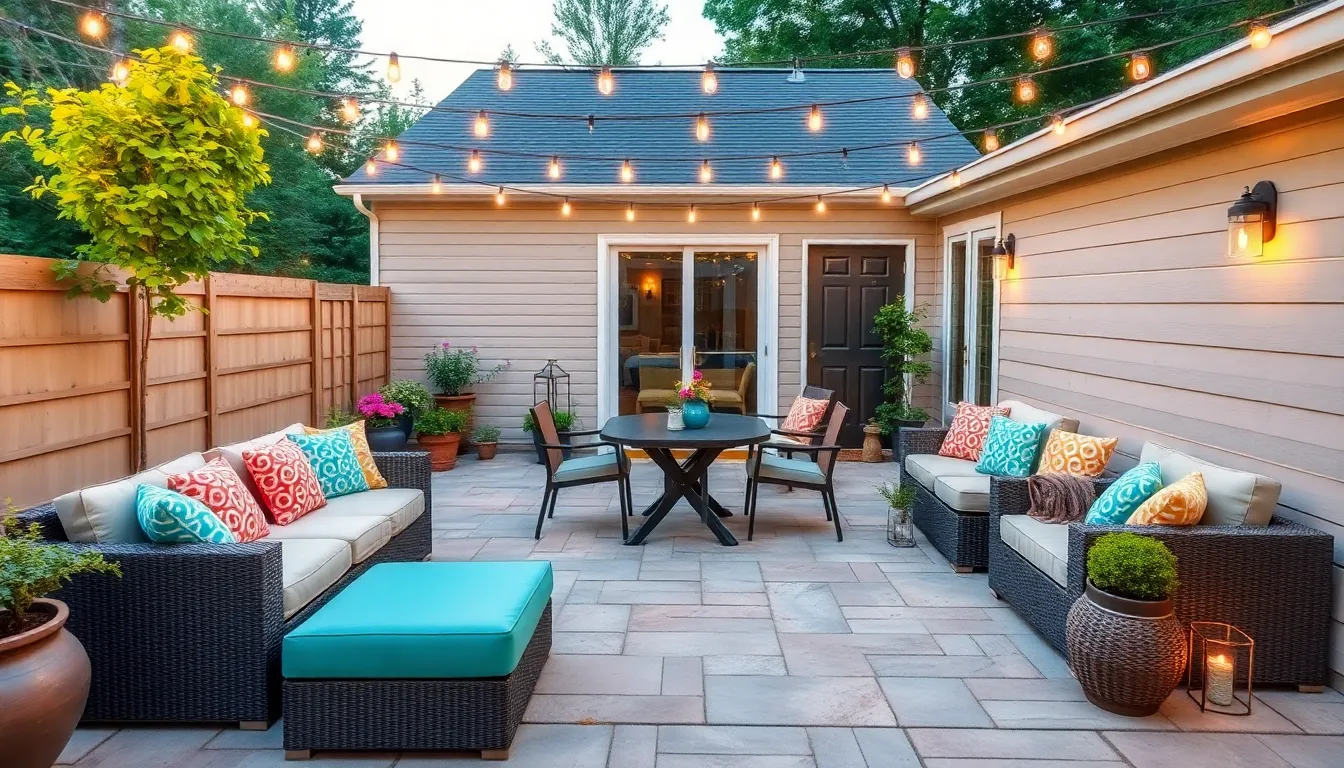
Designing a beautiful rectangular patio doesn’t require a substantial investment when you focus on smart layout strategies and cost-effective choices. We’ll explore practical approaches that maximize your outdoor space while minimizing expenses.
DIY Design Implementation Tips
Zone definition becomes effortless when we use simple furniture arrangements to create distinct seating and dining areas. Modular or lightweight furniture pieces allow easy setup and rearrangement without professional installation costs. String lights or solar lanterns provide affordable ambiance that doesn’t require electrical wiring or contractor fees.
Pre-made pavers or decking tiles offer the simplest installation method for DIY enthusiasts. These materials can be laid directly over a properly leveled base, eliminating the need for specialized tools or expertise. Outdoor rugs, colorful cushions, and strategically placed plants personalize the space inexpensively while adding comfort and visual appeal.
Symmetrical lounge setups create sophisticated looks using just two matching sofas or lounge chairs facing each other with a central coffee table. This balanced design promotes natural conversation flow and works effectively for both compact and spacious rectangular patios. Flexible arrangements that can be rotated or slightly modified allow homeowners to achieve maximum visual impact without costly custom landscaping or built-in features.
Dining-focused layouts maximize entertainment value by placing a long table centrally with comfortable seating around it. Adding a small bar cart or buffet table nearby enhances functionality without expensive built-in installations. This configuration suits outdoor meals and gatherings while maintaining budget-friendly appeal.
Cost-Effective Material Alternatives
Concrete pavers represent one of the most economical choices for rectangular patio foundations. These readily available materials offer durability, various textures, and multiple color options while remaining easy to install. Installation costs stay minimal compared to natural stone or custom concrete work.
Gravel or crushed stone provides excellent drainage properties at the lowest possible cost. This option requires minimal ground preparation and can be installed by homeowners with basic tools. Maintenance remains simple while providing a natural, rustic appearance that complements garden settings.
| Material | Cost Range | Installation Difficulty | Durability Rating |
|---|---|---|---|
| Concrete Pavers | Low | Easy | High |
| Gravel/Crushed Stone | Very Low | Very Easy | Medium |
| Stamped Concrete | Medium | Moderate | High |
| Reclaimed Wood | Low-Medium | Easy | Medium |
Stamped concrete delivers the visual appeal of stone or brick surfaces at significantly reduced costs. DIY-friendly techniques make this option accessible for homeowners with moderate skill levels. The finished appearance rivals expensive natural materials while maintaining long-term durability.
Reclaimed wood or composite decking materials offer eco-friendly alternatives that often cost less than new lumber. These options provide warm, natural aesthetics while supporting sustainable building practices. Composite materials require minimal maintenance compared to traditional wood surfaces.
DIY cement tiles allow creative homeowners to design unique patterns while controlling costs. Creating and painting custom tiles saves substantial money on distinctive designs that reflect personal style preferences. This approach enables artistic expression without the expense of imported or designer materials.
Conclusion
We’ve explored the endless possibilities that rectangular patios offer for creating stunning outdoor living spaces. From modern minimalist retreats to traditional garden sanctuaries these versatile layouts adapt to any style preference and budget constraint.
The key to success lies in thoughtful zone planning and strategic design choices that maximize both function and beauty. Whether you’re working with a compact urban space or sprawling backyard the principles we’ve shared will help you create an outdoor haven that serves your family’s unique needs.
Your rectangular patio has the potential to become the heart of your outdoor lifestyle. With careful planning and creative vision you’ll transform this simple geometric space into a beautiful extension of your home that brings years of enjoyment and countless memorable moments.
Frequently Asked Questions
What are the key benefits of rectangular patio designs?
Rectangular patios offer excellent space optimization, easy furniture arrangement, and natural zoning opportunities. Their structured shape allows for symmetrical layouts, efficient traffic flow, and versatile design options that work well with both modern minimalist and traditional aesthetics while maximizing every square foot of outdoor space.
How do I create different zones on a rectangular patio?
Divide your rectangular patio into functional zones using visual separators like area rugs, low planters, or built-in elements. Create dedicated spaces for dining, lounging, and cooking by positioning furniture strategically and maintaining clear pathways between zones for optimal flow and accessibility.
What furniture arrangement works best for small rectangular patios?
Optimize small rectangular patios with corner seating, built-in benches, and stackable furniture. Use vertical elements like wall-mounted planters and hanging lights to save floor space. Consider multi-level arrangements and floating furniture layouts to create distinct zones without overwhelming the area.
How can I make a large rectangular patio feel cohesive?
Create cohesion in large rectangular patios by establishing clear zones with consistent materials and color schemes. Use oversized furniture proportional to the space, incorporate architectural elements like steps or built-in features, and maintain visual connections between areas through strategic pathway design.
What lighting options work best for rectangular patios?
Implement multi-layered lighting with ambient perimeter lighting, task lighting for specific zones, and accent lighting for focal points. String lights, lanterns, and pathway illumination enhance safety and aesthetics. Consider overhead installations like pendant lights for dining areas and spotlighting for architectural features.
How do I integrate a pool with my rectangular patio layout?
Position poolside lounging areas for natural flow and convenience while maintaining clear pathways. Use consistent flooring materials for visual cohesion and implement safety features like slip-resistant surfaces. Create subtle visual barriers to separate pool and patio zones while preserving an open feel.
What are budget-friendly rectangular patio design options?
Use cost-effective materials like concrete pavers and gravel, incorporate DIY elements, and choose versatile modular furniture. String lights provide affordable ambiance, while symmetrical layouts maximize impact without expensive features. Focus on strategic plant placement and simple geometric arrangements for visual appeal.
How do I make my rectangular patio family-friendly?
Incorporate smooth, non-slip surfaces and rounded-edge furniture for safety. Create designated play areas with natural barriers and use durable, easy-to-maintain materials. Include multi-generational seating options and ensure accessible design features to accommodate various age groups and physical needs comfortably.

